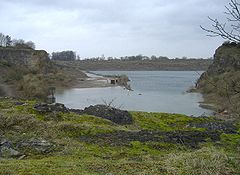| Magnesian Conglomerate | |
|---|---|
| Stratigraphic range: Rhaetian ~ | |
 Slickstones Quarry, where an outcrop of the Magnesian Conglomerate is present | |
| Type | Geological formation, fissure fill |
| Underlies | none |
| Overlies | Friars Point Limestone Formation? |
| Lithology | |
| Primary | Breccia |
| Other | Limestone |
| Location | |
| Coordinates | 51°30′N 2°36′W / 51.5°N 2.6°W |
| Approximate paleocoordinates | 35°54′N 0°48′E / 35.9°N 0.8°E |
| Region | South West England & South Wales |
| Country | |
| Extent | Bristol |
| Type section | |
| Named by | Henry Riley & Samuel Stutchbury |
| Year defined | 1836 |
The Magnesian Conglomerate is a geological formation in Clifton, Bristol in England (originally Avon), Gloucestershire and southern Wales, present in Tytherington, Durdham Down, Slickstones Quarry and Cromhall Quarry.
It dates back to the Rhaetian stage of the Late Triassic,[1][2] although it may be as old as the Norian stage of the Late Triassic and as young as the Hettangian stage of the Early Jurassic.[citation needed]
The Magnesian Conglomerate was first discovered in autumn 1834 and was studied in 1836 by Henry Riley and Samuel Stutchbury.[3]
The Avon Fissure Fill is often paired with the Magnesian Conglomerate.[1]
- ^ a b Magnesian Conglomerate in the Paleobiology Database
- ^ Weishampel et al., 2004, pp. 521–525
- ^ Riley & Stutchbury, 1836
